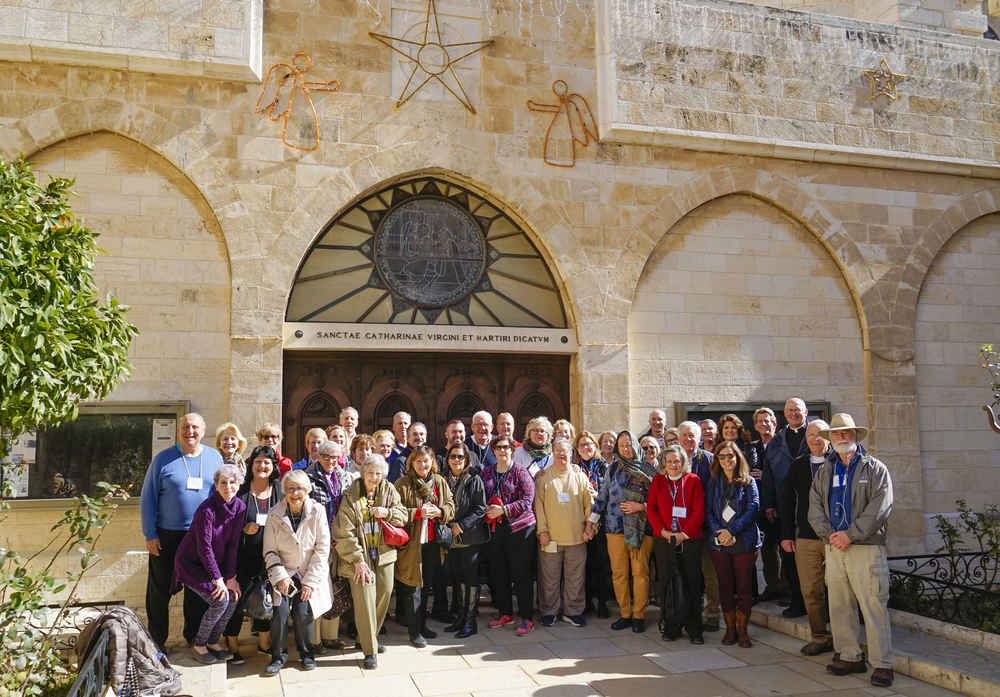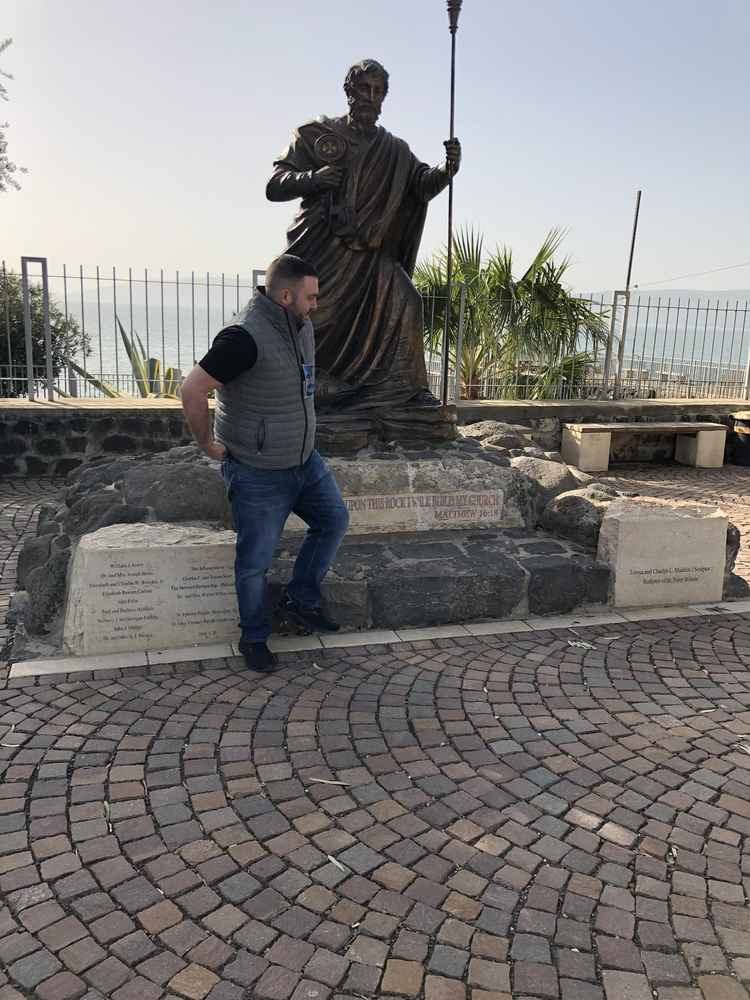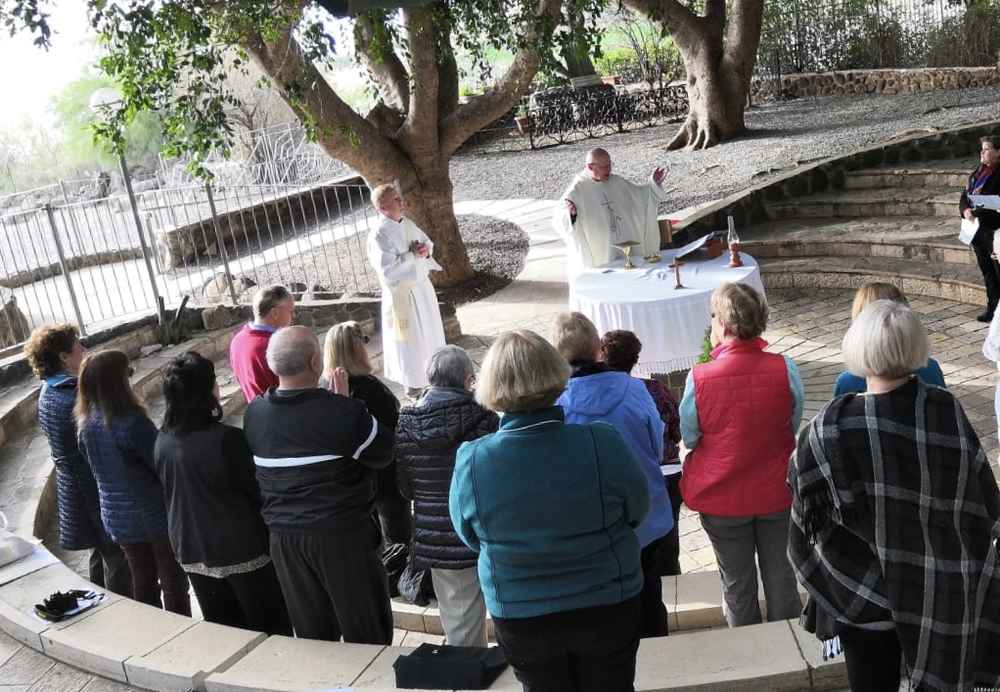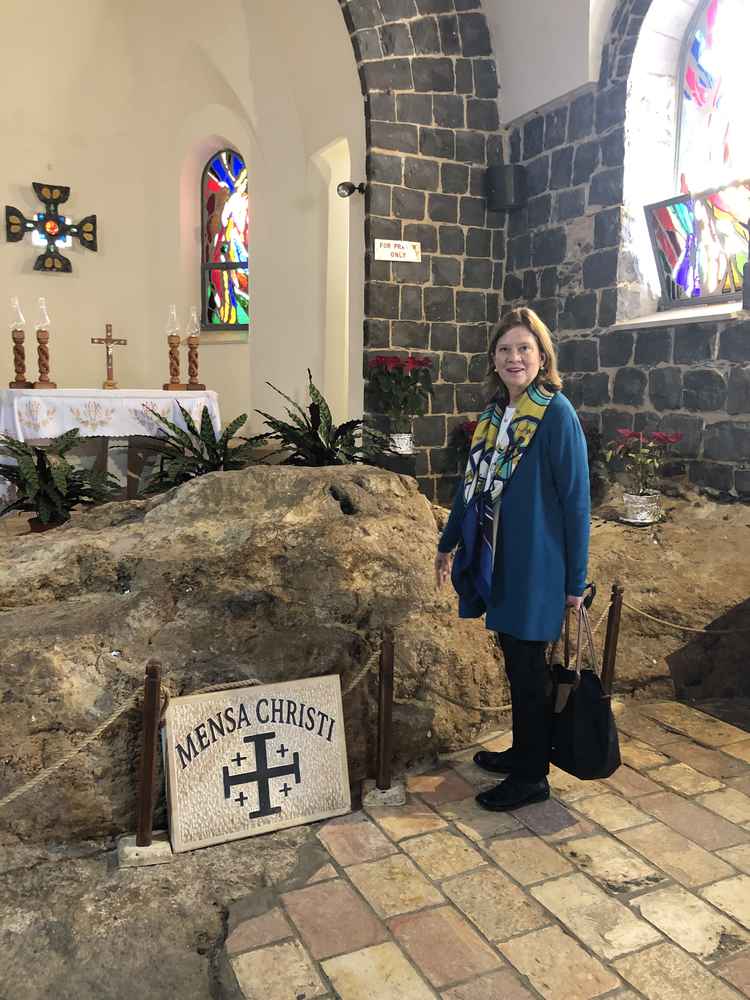Pilgrims Walk “Fifth Gospel” Way in the Holy Land

The pilgrims gather in the courtyard of St. Catherine’s Church, which adjoins the Church of the Nativity in Bethlehem. The 19th-century structure was built over the ruins of a Crusader church, which in turn was built over the 4th- and 5th-century monastery where St. Jerome translated the Bible into Latin.
The first sight of the Sea of Galilee—vast, shimmering and undisturbed—came for many of us from the windows of a guest house for pilgrims in Tiberius on a bright morning in late January. Buildings barely visible across the sea were so distant as to seem indistinct from whatever structures may have preceded them at the time Jesus walked these shores, and the water itself. That he did so became strikingly real, even familiar.
Many visitors to the Holy Land describe this perspective—gained in partaking of the sensory experiences of Jesus’s time on earth—as a “fifth gospel” that informs, ever after, their reading of the four canonical ones.
Our group of pilgrims—40 in all from various regions of the Federal Association, the American Association, and from no affiliation—had arrived in darkness the day before, to the sound of crickets, when the sea was apparent only in the flickering of buoy lights. The January 19-27 trip, “In the Footsteps of Jesus,” was organized and led by Michelle Bowe, DM, of the Montgomery County (Md.) Region, who is the Order’s ambassador to Palestine and president of Holy Family Hospital Foundation, assisted by Kate Robinson, the foundation’s director. Our spiritual leader was Msgr. Richard Cramblitt, a conventual chaplain from the Archdiocese of Baltimore, making his eighth pilgrimage to the Holy Land.
(Our local guide, a native of Bethlehem, Aramaic Christian and speaker of five languages, including Aramaic, the language of Jesus, provided the historical and biblical context. Much of the history and archeology discussed in this account—which covers just a few aspects of all we saw—derives from his learned discourses over long walks and bus rides.)
At Mass on our first evening, Monsignor placed our visit within a Christian pilgrimage tradition stretching back to the 4th century when St. Helena, mother of the Emperor Constantine the Great who legitimized the much-persecuted Christian religion in the Roman Empire, traveled to Jerusalem and other gospel sites and recovered relics, including remnants of the cross on which Jesus was crucified. Like Helena, we would immerse ourselves in the places of the life, death and resurrection of Jesus.
“This physical, spiritual, emotional, and intellectual experience puts into context, like nothing else can in our lifetime, the first four gospels,” said Peter-Anthony Pappas, KM, of the Northern Virginia Region. “This blessed and fortunate experience is one that I hope every Catholic can share in."
Our travel would divide into three phases: the public ministry of Jesus, the incarnation and birth of Jesus, and the passion of Jesus, with side trips to see works of the Order in the Holy Land during the era of the Crusades and the present, and to encounter at first-hand the plight of Palestinians living on the West Bank.
Our spiritual itinerary, as set by Msgr. Cramblitt, would follow the form of praising God, thanking God, examining areas in need of healing and forgiveness in our lives, and petitioning for personal intentions. The goal would be entering deeper into the “family” to which Jesus invited his disciples who left all to follow him.
At Mass each day Monsignor, speaking from his experience, would greet us with the assurance that this day, like the previous one, was “my absolute favorite day of the pilgrimage.”
The walk in 1st-century footsteps began at Tabgha, a site associated with Jesus’s third post-resurrection appearance to his disciples. From a fishing boat put out to sea they glimpsed him on the shore grilling fish. According to tradition rooted in archeological evidence, those fish were served on a rock now located in front of the alter of a Franciscan church, known as Mensa Christi, or Table of Christ. Monsignor celebrated Mass in a shaded grove a few yards away from the church, which was built atop ruins of a 4th-century predecessor, still evident in whitened stone steps at the water’s edge where Jesus forgave Peter for denying him. “Peter do you love me …” We pilgrims touched the water. Some cupped and drank it, sweet and fresh.
“I was overwhelmed,” said Kate Goonan, a candidate in the Baltimore Region, reflecting on this first footstep in the pilgrimage. “I’ll never read the Gospels in the same way. We walked where these events occurred, almost 2000 years ago.”
The interpretation of the layers at Tabgha introduced us to the method of analysis for the authenticity of many of the claims we would hear for sites along the pilgrimage. Structures built within recent centuries stood on the ruins of a much earlier century, sometimes with an even earlier structure beneath that one, anchoring the site in gospel history.
Capernaum, where Jesus began to preach the good news, consists of ruins of several 1st -century houses, including one identified by ancient graffiti as the house of Peter’s mother-in-law. Steps away from the Sea of Galilee on one side and a key highway connecting North Africa to the Middle East on the other, it would have been the obvious and convenient place for Peter to fish and sell his catch and, as a busy crossroads, for Jesus to spread his message. Across the way from the house are the remains of synagogue from the period where Jesus would have taught.
At nearby Cana, where Jesus performed his first public miracle, turning jars of water into wine, a 1st-century stone cistern gave a sense of the amount of refreshment needed to entertain guests for seven nights, the standard duration of wedding feasts then, and apparently still today. In a chapel below the church commemorating the event, Msgr. Cramblitt presided over a renewal of the wedding vows of the couples within our group, plus a pair of strangers from California who asked to join in.
“Since we were at Cana, the scene of Christ’s first miracle, the renewal of our vows was natural, meaningful, and joyful,” said Jim and Georgia Lynch, KM and DM, of the Kansas City Region, married 51 years.
Malta members who have made the pilgrimage to Lourdes, with its abundant souvenir shops, will know well how holy sites attract nearly as many entrepreneurs as pilgrims. Outside the Church at Shepherds Field, where we had Mass in a cave perhaps inhabited by the shepherds attending the nativity of Christ, a boy cradling a lamb charged three shekels for a shepherd-boy photo opp. At the foot of the mount in the Judean Desert where Jesus was tempted by the Devil, the sprawling gift shop billed itself as Temptation Gallery. On a short tour boat excursion onto the Sea of Galilee, the crew played the “Star-Spangled Banner” and the Elvis version of “Amazing Grace,” and offered to sell us stones from the sea, wrapped in wire crosses and displayed on a velvet cloth like cut diamonds. Off to port, another tour boat carrying Chinese visitors played their anthem, “March of the Volunteers.”
The mid-phase of the pilgrimage took us to the Church of the Nativity in Bethlehem and on to Nazareth for two possible sites for the Annunciation. The first, based on the location of the town well and ancient pipes leading from it, is claimed by the Orthodox. The other, based on the traditionally recognized location of the house of the parents of the Blessed Virgin, is claimed by the Catholic Church. At the outset of the 15-minute walk from the Orthodox site to the Catholic, over hilly, uneven streets, our guide admonished us not to complain of its arduousness since Mary, as a young girl, would have traversed this same way twice daily with a water jar on her head.
“I keep thinking about the power of Mary's 'yes' and the presence of Mary in the Holy Land,” said Mimi Fleury, DM, of the Montgomery County (Md.) Region. “Visiting the Church of the Annunciation where, in Latin, 'The word was made flesh here,' was overwhelming. And then when we got to Jerusalem—the agony of Jesus and Mary. She was a widow, just like me.”
From our final lodgings at a hotel in Bethlehem, the phase of the passion, death and resurrection stretched the longest. One day, after descending the Mount of Olives, past an ancient ossuary from which Jesus gazed across the Kidron Valley and wept over Jerusalem on the other side, we reached the Garden of Gethsemane. Some of its olive trees were as old as a millennium. Many of these grew from roots dating to the 1st century, having survived the razing of the garden by Muslim conquerors seeking to discourage Christian veneration. Inside the Basilica of the Agony next door, in a powerful instance of form following function, a French priest concluded Mass from an altar shaped like a chalice in front of a rock said to be the one from which Jesus prayed that the chalice of his passion would pass from him, before being arrested and sentenced to crucifixion.
The footsteps continued to the slope of Mount Zion, to the Church of St. Peter in Gallicantu (meaning cock crow), just outside the Old City of Jerusalem, where Peter denied Jesus three times. The site is thought to be the house of the High Priest Caiaphas, and the place where Jesus was held after his arrest and scourged. Out of the silence that came over the various pilgrim groups descending to a cavern beneath, in what would have been the prison, Msgr. Cramblitt read aloud from a notebook placed there and opened to a copy of Psalm 88:
“I am counted among those who go down into the Pit;
“I am like those who have no help …”
Entering the city through the Lion’s Gate, we walked the Via Dolorosa, the way that Jesus carried his cross, praying the Stations of the Cross amid the noise and press of crowds, eventually coming to rest in the courtyard of the Church of the Holy Sepulchre. Jim Lynch of Kansas City said the pilgrimage focused him on the humanity of Jesus, especially as he recalled “how physically taxing it was in praying and always going uphill” along the Via Dolorosa.
According to tradition dating to at least the 4th century, the church encompasses Calvary, some rock split by the earthquake at the crucifixion, the empty tomb, and more. Just inside the front doors, pilgrims speaking many different languages were kissing and rubbing their hands over a stretcher-sized stone slab where Jesus’s crucified body was prepared for burial. Deeper inside, a line formed for the tomb. It thickened, halted, then swayed with some violence as a group of Coptic Christians elbowed their way across to reach one of their chapels. Gradually, after a Greek Orthodox Mass and procession concluded, the line began inching toward a small church within the cavernous rotunda, its entrance festooned with colored lanterns. Stepping through a low door, we entered an antechamber and encountered a large stone. The Greek Orthodox priest directing traffic within identified it, in minimal but sufficient English, as the stone that had sealed the tomb, “the rolling stone,” he said. Four at a time, we filed into the inner room where the tomb itself is covered with stone beneath an altar.
Emerging from the closeness of the tomb, we moved across the rotunda up a few flights of stairs, up the rocky hill of Golgotha. Though the line there was thin, several broad-shouldered Orthodox priests closely directed visitors before a backdrop icon of a slightly larger than life-sized of Jesus on the cross. Under glass on either side sides were rock surfaces where Roman soldiers might have stood. Just in front of the cross was an altar and beneath it a hole for pilgrims to reach, up to the elbow, to touch the Skull Place itself.
At times during the pilgrimage, we diverted from the actual footsteps of Jesus to take in evidence of what followed from that walk; specifically, the Malta heritage and present witness amid the Israeli-Palestinian conflict.
From the Carmelite monastery atop Mount Carmel in Haifa, our mid-pilgrimage lodging, we traveled to Akko, known during the time of the Crusades as St. John Acre, where the Order of Malta built a hospital in the mid-12th century—its third since a group of serving brothers, later known as the Hospitallers, built the first one in Jerusalem a few decades earlier. The largely intact stone superstructure includes an open courtyard for military training, a refectory, a communal latrine with elaborate stone seating, all underlain with a network of tunnels that eventually open onto a small, not-so-modern port city. Wandering through alleys lined with shops and hanging laundry, further animated by a man gutting a 4-foot fish and spilling blood and viscera onto the sidewalk, it was possible to imagine the scene from the Crusaders’ time, but for the honking cars navigated by drivers supremely confident in pedestrians’ ability to yield the right-of-way.
Linking the medieval presence to the present for us was the Holy Family Hospital, a maternity hospital in Bethlehem, located just 1,500 steps from the Church of the Nativity. It is run by the Order as the only shared work of associations across several countries. After walking around the corner from our hotel for a visit, we learned that, last year, the staff delivered more than 4,600 babies and performed more than 40,000 services at the hospital and from a mobile clinic operating in the desert. The cost of care is subsidized at the base rate 50 percent, and much more for poor patients, all with funds raised by the Grand Magistry and Order-related foundations in various countries, the largest of which is Holy Family Hospital Foundation based in Washington, D.C., and supported by the three U.S. associations. No one is turned away, “regardless of need or creed,” as the staff likes to put it.
Employing more than 170 people, both Christian and Muslim, the hospital does it part to stem the exodus of Christians from Bethlehem, once a predominantly a Christian area. While many seek to escape the political and economic restrictions the Israeli government imposes on the West Bank, the hospital spokeswoman briefing us on its work said the opportunity to participate in the mission of a Catholic hospital practicing in accord with Church teachings provided strong incentive to stay and pursue a career in her hometown. Just outside one of the birthing rooms where a newborn was uttering its first cries, a midwife described the essentials of her profession as having “the heart of a lion, the eyes of an eagle, and the hands of a lady.”
Like many, Mimi Fleury from Montgomery County was impressed by “the extraordinarily high morale of the staff who work in challenging conditions” and by the hospital itself as “an oasis of hope in a bleak, holy city.”
We looked closer at the bleakness in a visit to the Aida refugee camp abutting the graffiti-covered wall, crossed only through military checkpoints, separating Bethlehem in the West Bank from the outskirts of Jerusalem in Israel. The squat, drab concrete buildings were constructed by a United Nations agency to accommodate Palestinians dispossessed of their homes following Israel’s declaration of independence in 1948.
Walking mostly deserted, dingy streets, we came to a community center housing a theater company that produces plays reinterpreted as messages of resistance. The theater director who addressed us was born in the camp to parents who were among the original refugees. After earning a Ph.D. in Paris, he returned to the camp, rather than remake his life elsewhere, staying as a statement of resistance. Many of the staff of Holy Family Hospital also live there.
For Linda Couzens, a dame with the American Association, who is a nurse in northern Michigan, the opportunity to visit and connect the work of the hospital with life in the camp is what drew her to the pilgrimage.
“The pain of the people was palpable,” she said. “The dedication of the hospital staff was immeasurable. The babies were ‘the most vulnerable among us.’” Her lasting impression a few days after returning home: “The joys and sorrows were all around.”
The last day of pilgrimage began with a bus ride through the Judean Desert, the thin green ground cover giving way to rippling, khaki-colored hills, to the Jordan River just outside Jericho. It was marine biology rather than archeology that backed the claim for this being the site of the baptism of Jesus by John the Baptist. It was here that fish swimming south from the Sea of Galilee would be overcome by the increasing salinity on the approach to the Dead Sea, and would jump to the shore—a metaphor for seeking new life. The river, marking the border with Jordan, was only about 20 yards wide, slow and muddy brown. Among pavilions along a small bluff, pilgrim groups worshipped and sang. For a Polish group, the after-Mass social consisted of changing into swimsuits, donning long white garments and wading waist-deep into the water to splash each other.
The intensity of a pilgrimage tends to dissolve pretense and draw initial strangers into friendship. There is little room for small talk while standing before the places of Christ’s birth, preaching, passion, death and resurrection. Enhancing this fellowship was rich dining in Palestinian restaurants flourishing far beyond the notice of standard tourist guides. Most meals began with a shared repast, mostly small plates of vegetables, sauces and humus—rapidly elaborated by waiters rushing in every five minutes with new variants. Only after the dinner table was nearly covered did the main course arrive, followed by dessert.
At our last meal in Bethlehem, a Christian dance troupe performed traditional Palestinian routines that are still part of weddings and other celebrations today. As the last course concluded, the dancers waded among us, drawing some very self-confident members onto the dance floor for step-dancing in a circle. The more limber and adventurous of these recruits entered the center of the circle for a Simon-says-style tutorial in high kicking.
Study of the fifth gospel engages students in their every capacity, even the physical, leaving all forever changed.
— Kate Goonan, a candidate in the Baltimore Region, contributed to this article.
Pilgrims dine in the port city of Haifa, near the foot of the monastery at Mount Carmel.

Peter-Anthony Pappas stands before a bronze of St. Peter at Capernaum, on the Sea of Galilee, where Peter plied his trade as a fisherman.

Msgr. Richard Cramblitt celebrates Mass, assisted by Deacon Michael Stankewicz, under the shade by the Sea of Galilee.

Mimi Fleury inspects the rock of the Mensa Christi, where Jesus is thought to have served the fish grilled in the shore in his third post-Resurrection appearance.
